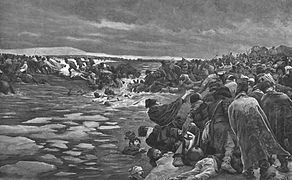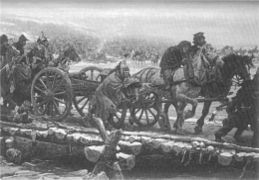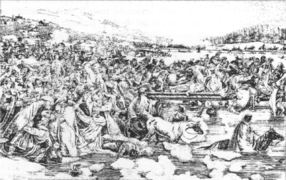Battle of Berezina
| Battle of Berezina | |||||||
|---|---|---|---|---|---|---|---|
| Part of the French invasion of Russia | |||||||
 Napoleon's crossing of the Berezina an 1866 painting by January Suchodolski oil on canvas, National Museum in Poznań | |||||||
| |||||||
| Belligerents | |||||||
|
|
| ||||||
| Commanders and leaders | |||||||
|
|
| ||||||
| Strength | |||||||
| 49,000 combatants, at least 40,000 stragglers, 250-300 guns[1] | 86,500 combatants[2] | ||||||
| Casualties and losses | |||||||
| 22,000 combatants,[3] 35,000 stragglers[4] | 10,000 combatants[5] | ||||||
The Battle of (the) Berezina (or Beresina) took place from 26 to 29 November 1812, between the French army of Napoleon, retreating after the aborted occupation of Moscow and trying to cross the Berezina (near Borisov, Belarus), and the Russian armies under Peter Wittgenstein and Admiral Pavel Chichagov. The battle ended with a mixed outcome. The French suffered heavy losses but Napoleon with the core of his army managed to cross the river.[6]
Background[]
The French had suffered a defeat just two weeks earlier during the Battle of Krasnoi. Napoleon's army amounted to no more than 20,000 combatants. However, the union with Victor, Oudinot and Dombrowsky brought the numerical strength of the Grande Armée back up to some 49,000 French combatants as well as about 40,000 stragglers.[1] But Minsk had been occupied by Chichagov on 16 November 1812 who reached the Berezina with about 31,500 combatants. Wittgenstein had more than 30,000. Miloradowitch had more than 25,000. By that the Russian army had approximately 86,000 troops at the Berezina.[4]
Kutuzov with another 39,000 was approaching the river but was 40 mi (64 km) to the east and not involved in the fighting. The British general Wilson who wanted Napoleon to be attacked already at the Battle of Maloyaroslavets instead of retreating had protested against Kutuzov's strategy. Kutuzov had replied to him, here simplified for a better understanding: "I am by no means sure that the total destruction of the Emperor Napoleon and his army would be such a benefit to Russia; his succession would fall to the United Kingdom whose domination would then be intolerable."[7]
Battle and crossing[]
Napoleon's plan was to cross the Berezina River and head for Poland, but the usually frozen waterway had thawed and was now impassable.[8] Chichagov, Wittgenstein and Miloradowitch wanted to trap and eliminate him at the Berezina.
On the 22nd the nearby bridge at Borisov had been destroyed by the Russians.[9] Napoleon had ordered the equipment to build a pontoon bridge to be destroyed a few days earlier. However, the commander of the bridging equipment General Jean Baptiste Eblé had disobeyed Napoleon's order to abandon equipment, instead retaining crucial forges, charcoal and sapper tools.[8]
On the 25th bridge construction started in Studienka north of Borsisov as Marshal Oudinot drew off Chichagov's army. He moved towards the south of Borisov faking to build a bridge and make a crossing. Chichagov followed him on the other side of the Berezina and Studienka was free for the French army.[10]
On the 26th most of Eblé's Dutch engineers died for their comrades to construct the vital 100 m (330 ft) bridges. Hypothermic death in less than 30 minutes of exposure was likely. A first and second structure were created within hours and cannons were taken across them to bolster the defensive perimeter.[11]
By midday of the 27th, Napoleon and his Imperial Guard were across. One of the spans broke in the late afternoon, but more feats of engineering skill had it repaired by early evening.[12] The corps of Marshal Davout and Prince Eugene also crossed, leaving Marshal Victor's IX Corps to hold off the enemy on the east bank.[13]
On 28 November a human stampede caused by the stragglers wanting to cross the small bridges occurred. Men, and even women and children, were trampled underfoot. Hundreds drowned while trying to swim across the Berezina. Towards 10 p.m. the IX Corps made his crossing.[14]
On 29 November by 1 a.m. the bridges were free. The commander of the bridging equipment General Jean Baptiste Eblé disobeyed Napoleon's order to burn the bridges at 7 a.m., but finally did it at 8:30 a.m. Tens of thousands of French stragglers and civilians were left behind on the eastern bank of the Berezina and were killed or taken prisoner by the Russians.[15]
...The unfortunate men who had not taken advantage of the night to get away had at the first appearance of dawn rushed on to the bridge, but now it was too late. Preparations were already made to burn it down. Numbers jumped into the water, hoping to swim through the floating bits of ice, but not one reached the shore. I saw them all there in water up to their shoulders, and, overcome by the terrible cold, they all miserably perished. On the bridge was a canteen man carrying a child on his head. His wife was in front of him, crying bitterly. I could not stay any longer, it was more than I could bear. Just as I turned away, a cart containing a wounded officer fell from the bridge, with the horse also. They next set fire to the bridge, and I have been told that scenes impossible to describe for horror then took place...[16]
Casualties[]
David G. Chandler wrote in "The Campaigns of Napoleon"[5]
(...)"the cost in terms of human lives will never be known with any accuracy. Probably between 20-30,000 French combatants became casualties during the three days of the operation; worst hit in this respect were the IInd and IXth Corps, which lost more than half of their effective strength in their important roles of protecting the bridgehead area. To the number of the slain in action must be added probably as many as 30,000 noncombatants; not all these died during the crossing operation, but the large number that fell into Russian hands succumbed almost to a man of exposure and starvation during the following days. Huge quantities of booty fell into the hands of the Cossacks, but it is noteworthy that the French only abandoned 25 guns to the enemy. For their part, the Russians lost at least 10,000 killed over the same period and many more wounded."
Aftermath[]
Napoleon was in a position to claim a strategic victory, having snatched what was left of his army from a seemingly unavoidable catastrophe, and opened the road to Vilna for himself and to the remainder of his army. But probably 20-30,000 combatants became casualties. "To the number of the slain in action must be added probably as many as 30,000 non-combatants."[5]
The losses had been extraordinary. The Guard, which had not come into action at all, lost about 1,500 men out of 3,500. The total of French losses can only be estimated at about 30,000. But much had been saved. Napoleon, his generals, and thousands of officers and veteran soldiers had been saved.[2]
There would be no large military confrontation for the rest of the retreat, although the incessant harassment of Russian Cossacks and the weather continued to dwindle the French army.[5]
Empire of Death
The next two days were, according to some, among the worst of the entire retreat... ...no fallen horse or cattle remained uneaten, no dog, no cat, no carrion, nor indeed, the corpses of those who died of cold and hunger..[17]
Napoleon left his army on 5 December at Vilna. The temperatures dropped to -33.75 ℃ on 8 December. 36,000 French prisoners were taken by the Cossacks between 1 and 14 December. On 8 December the number of combatants was down to 4,300. On 14 December the rest of the French main army crossed the Niemen. The only troops that had remained were the flanking forces (43,000 under Schwarzenberg, 23,000 under Macdonald), about 1,000 men of the Guard and about 40,000 stragglers. No more than 110,000 were all that was left from 612,000 (including reinforcements) that had entered Russia. The Russian losses may be about 250,000 men.[18]
In popular culture[]

Leo Tolstoy references the battle in his novel War and Peace
The Battle of Berezina is depicted in 1956 film War and Peace.
Kutuzov, Russian movie (1943) with English subtitles describes also the Battle of Berezina.
The construction of a bridge over the Berezina is described in Honoré de Balzac's novel The Country Doctor.[19]
The phrase "c'est la Bérézina" is an expression used in the French language with the sense of "it's a humiliating defeat" or "it's a disaster".[20]
The Beresinalied, song of the Berezina, became a symbol of the sacrifices of Swiss mercenaries in foreign service.
Gallery[]
The drama of the battle's story inspired many works of art centred on the crossing.

Crossing of the Berezina, Felician Myrbach

Le passage de la Bérézina, Joseph Raymond Fournier-Sarlovèze

Crossing the Berezina River on 17 November 1812, Peter von Hess

La traversée de la Bérézina en 1812, Jan Hoynck van Papendrecht
Crossing at Berenzina, Julian Fałat

Übergang über die Berezina, unknown
Notes[]
- ^ Jump up to: a b Chandler 1966, p. 841.
- ^ Jump up to: a b Riehn 1990, p. 387.
- ^ Chambray 1823, p. 300.
- ^ Jump up to: a b Riehn 1990, p. 377.
- ^ Jump up to: a b c d Chandler 1966, p. 846.
- ^ Wilson 1860, p. 177.
- ^ Wilson 1860, p. 234.
- ^ Jump up to: a b Riehn 1990, p. 373.
- ^ Riehn 1990, p. 376.
- ^ Riehn 1990, p. 379.
- ^ Riehn 1990, p. 381.
- ^ Riehn 1990, p. 382.
- ^ Riehn 1990, p. 383.
- ^ Riehn 1990, p. 385.
- ^ Riehn 1990, p. 386.
- ^ Bourgogne 1899, p. 205.
- ^ Zamoyski 1980, p. 483.
- ^ Riehn 1990, p. 390.
- ^ Balzac 1887, p. 101.
- ^ "C'est la Bérézina : signification et origine de l'expression". L'Internaute. Retrieved 19 April 2021.
References[]
- Bourgogne, Adrien Jean Baptiste François (1899). Memoirs of Sergeant Bourgogne, 1812-1813. Retrieved 13 March 2021.
- Chandler, David (1966). The Campaigns of Napoleon. Retrieved 13 March 2021.
- Riehn, Richard K. (1990). 1812 : Napoleon's Russian campaign. Retrieved 13 March 2021.
- Chambray, George de (1823). Histoire de l'expédition de Russie. Retrieved 13 March 2021.
- Wilson, Robert Thomas (1860). Narrative of events during the Invasion of Russia by Napoleon Bonaparte, and the Retreat of the French Army, 1812. Retrieved 13 March 2021.
- Zamoyski, Adam (1980). Moscow 1812: Napoleon's Fatal March. Retrieved 13 March 2021.
- Balzac, Honore de (1887). The Country Doctor. Retrieved 13 March 2021.
Sources[]
- Mikaberidze, Alexander (2010). Napoleon's Great Escape: The Battle of the Berezina. London: Pen and Sword. ISBN 978-1-84415-920-8.
- Morelock, Jerry, Napoleon's Russian nightmare. Misjudgments, Russian strategy and "General Winter" changed the course of history, 2011
- Pigeard, Alain - "Dictionnaire des batailles de Napoléon", Tallandier, Bibliothèque Napoléonienne, 2004, ISBN 2-84734-073-4
- Pigeard, Alain - "La Bérézina", Napoléon Ier Editions 2009
- Tulard, Jean - "Dictionnaire Napoléon"; Librairie Artème Fayard, 1999, ISBN 2-213-60485-1
- Weider, Ben and Franceschi, Michel, The Wars Against Napoleon: Debunking the Myth of the Napoleonic Wars, 2007
- Conflicts in 1812
- Battles of the Napoleonic Wars
- Battles involving Poland
- Battles involving Russia
- Battles involving France
- 1812 in the Russian Empire
- 1812 in Belarus
- Barysaw
- November 1812 events
- Battles of the French invasion of Russia
- Military history of Belarus
- Minsk Governorate






